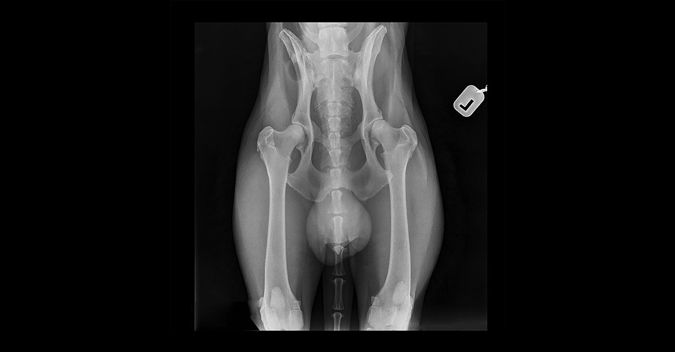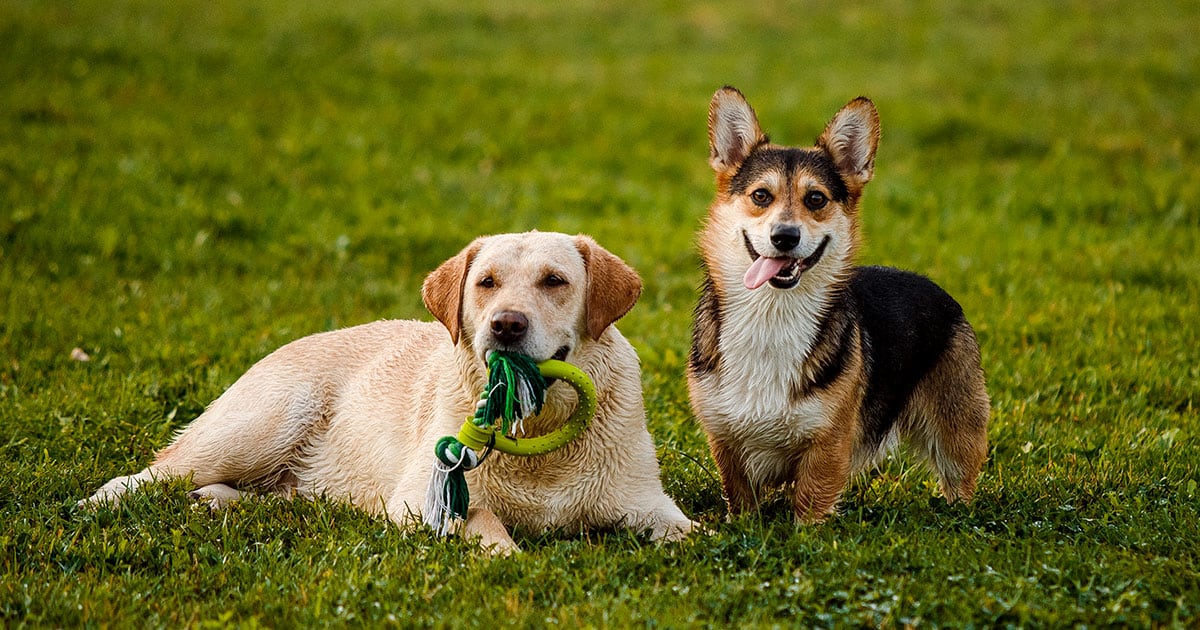Canine hip dysplasia (CHD) — “dysplasia” means abnormal or faulty development — is a complex skeletal disease in which the hip joints of a growing puppy develop abnormally. It’s seen most commonly in larger dog breeds, generally those weighing more than 50 pounds, although CHD can occur in smaller breeds, too.
Since the condition can affect the top five most popular dog breeds — Labrador retriever, German shepherd, golden retriever, French bulldog and bulldog — we’ll review the basics of this painful and debilitating condition.
The normal hip joint and what happens when development goes awry

To fully understand the impact hip dysplasia has on affected dogs’ mobility and comfort, it helps to know a little anatomy and physiology.
You may remember from biology or anatomy class that the hip (aka coxofemoral) joint is a ball-and-socket joint. The “ball” is the head of the femur, or main bone of the thigh, and the “socket” is a cup, known as the acetabulum, located on the pelvis.
In a normal, healthy joint — like the hips in the X-ray — the bones are shaped to match each other, with the ball fitting snugly into the socket. Joint cartilage covers the entire head of the femur and lines the acetabulum so that the bones glide smoothly and freely during movement. A strong ligament attaches the head of the femur directly to the socket and holds the two bones together. The entire joint is surrounded by the joint capsule, a tough connective tissue that keeps synovial fluid within the joint. All of these parts work together to enable normal gaits and movements.
As a normal, healthy puppy grows, both the ball and socket must grow at equal rates to maintain their snug fit. But in puppies affected by hip dysplasia, uniform growth in the joint structures doesn’t happen and results in joint looseness (laxity). The femoral head and the acetabulum move abnormally in relation to each other: the ball moves too much in its socket or the socket may be too shallow for the ball to fit normally. The abnormal movement leads to stress and strain on the joint that in turn lead to inflammation, damage to joint tissues, arthritis and pain.
What causes hip dysplasia?
According to the Pet Health Network, hip dysplasia is a genetic condition with a complicated inheritance controlled by many genes. Expression of these genes can be influenced by environmental factors such as growth rate, diet, exercise, pelvic muscle mass and hormones. Rapid weight gain and extra body weight can contribute to and worsen the development of CHD. What this means is that, if you have a large breed puppy, you’ll want to keep him or her at a normal, lean weight during growth and avoid overfeeding that encourages dogs to grow “big” and fast.
Signs and symptoms to watch for
Signs and symptoms of hip dysplasia are very similar to those of arthritis. They will also vary depending on the extent of joint changes. Here are symptoms and signs you should watch for:
- Rear leg lameness that may be mild, moderate or severe and is worse after exercise
- “Bunny hopping”
- Reluctance to walk, play, jump or climb stairs
- Difficulty getting up or lying down
- Decreased activity level
- Hip pain and sensitivity
- Audible clicking sound made by the hips while walking
- Muscle wasting (atrophy) in the rear legs
Some of these signs may be seen in puppies as young as 5 or 6 months old, but may not be noticed until the dog is 1 to 2 years old. In some cases, however, your dog may not show signs or symptoms until he or she reaches middle age or later.
Specialized X-rays are key to diagnosis
Because hip dysplasia can be inherited, dogs of at-risk breeds should be evaluated before they’re bred. Currently, hip X-rays taken while the dog is under general anesthesia or deeply sedated is the preferred method for diagnosing hip dysplasia. Any licensed veterinarian can take and submit X-rays to the Orthopedic Foundation for Animals (OFA) for evaluation provided that the instructions for correct X-ray positioning and identification are followed. Following the submission of a dog’s single hip X-ray, three board-certified veterinary radiologists evaluate nine anatomic bony structures for dysplasia. An application and service fee must also be submitted at the time of X-ray submission.
A second method for diagnosing hip dysplasia via X-rays is also available. PennHIP (University of Pennsylvania Hip Improvement Plan) testing evaluates both bony and soft tissue structures to determine joint stability. The X-rays are taken under general anesthesia or heavy sedation because complete relaxation of the muscles around the hip joint is necessary to obtain diagnostic X-rays. A special positioning device is used when obtaining one of the three X-rays that are submitted for evaluation by an imaging service. Practicing veterinarians who offer PennHIP testing must be certified first by completing online training and proficiency testing. The price of a PennHIP evaluation is set by each certified veterinarian.
Managing dogs diagnosed with CHD
Options for treating and managing hip dysplasia are available if your dog is diagnosed with the condition. A combination of a healthy weight and diet, pain management therapies, joint health supplements and appropriate exercise can keep many dogs comfortable. Several surgical treatment options are also available, depending on your dog’s age and the severity of the disease. Your veterinarian is your best resource for evaluating and treating your dog’s health, including his or her joint health. Be sure to talk with your veterinarian about whether your dog should be evaluated for evidence of hip dysplasia.
RELATED POST: Should You Be Feeding a Large Breed Formula?







